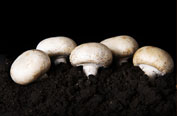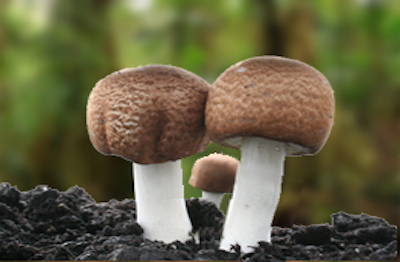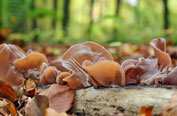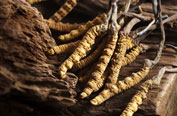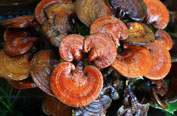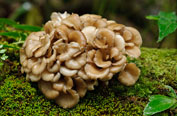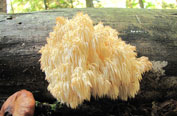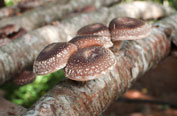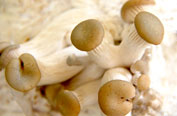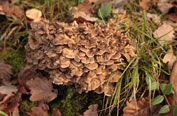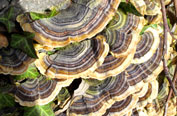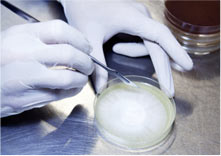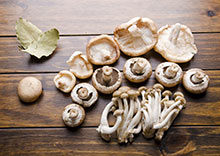
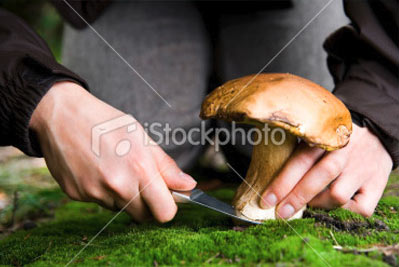
Inoculation of wood logs with spawn dowels
(Level 1 – beginner)
The inoculation of wood logs or stumps with spawn dowels can be done throughout the whole year, if the logs/stumps are stored frost-free during spawn run, until they are fully colonised. Depending on the species, the mushroom fruits for several seasons until all the nutrients in the wood have been consumed.
Recommended equipment:
Wood logs or stumps
Wood saw
Tub for soaking
Drilling machine and 9 mm (0,35 inch) drill
Spawn dowels (wood dowels, fully colonised with mycelium)
Jute bag
Sealing wax
Hammer
Preparations
The quality of the wood is crucial for successful cultivation. After you have cut the wood, make sure to store it in a dry place for 2-3 weeks, then prepare it as follows:
Soak the entire log for 3 days in a tub and leave it to dry on a canvas outdoors for one day. The primary choices of material are wood logs with bark, with 20-35 cm (7–14 inch) in diameter and 90-120 cm (35–47 inch) long.
After delivery the spawn dowels should be left to rest for 2 or 3 days at room temperature (maximum 29°C / 84°F) to give the mycelium time to recuperate from its journey. If you do not plan to use the spawn dowels immediately after the recuperation, please store in the fridge at 2 – 4°C/ 36 - 39°F and use them within a few weeks.
Inoculating the logs
Cut off about 2 cm of each end of the trunk directly before inoculation to prevent unwanted fungal growth and contamination and throw the pieces away. Now drill about 50 holes of 3-4 cm (1,2–1,6 inch) depth all around the log evenly. Take care to work slowly, if the wood heats up too much while drilling it might affect its quality! Now place the dowels into the holes carefully. Take care not to injure the mycelium. We recommend to inoculate the cut surfaces too for even better results.
For logs we recommend to use about 50 spawn dowels, for stumps 30 – 50 spawn dowels. As soon as the whole log is inoculated, close the holes with sealing wax. The simplest method is to apply warm, liquid wax with a paint brush and immerse the cut ends.
Mycelium growth
For mycelium development/spawn run, wrap the trunks in moist jute bags and put them in a shadowy place in your garden or in a well-ventilated basement for about 10 weeks. The jute bags need to stay moist. The spawn run phase is over as soon as white mycelium can be seen besides the holes. (Recommended temperature: 'spawn run' – depending on species)
Setup in the garden and further care
As soon as the logs are fully colonised, dig a hole of 15 cm (6 inch) depth in a shady place in your garden and place the log in an upright position. For cultivation on a shady balcony or terrace use a flower pot filled with sand or pebbles. Keep the wood and the soil around it moist and water them on a periodical basis. The fruiting bodies develop during the season providing the natural weather/fruiting conditions - depending on the species.
Wintering
To protect the logs against frost, just wrap them in jute bags during winter. In spring time, bags are removed and the logs are sprayed with water.
Fighting snails
Snails love mushrooms! To prevent these voracious creatures from destroying the whole crop, we recommend building a snail fence around the log. Don’t use slug and snail bait or other chemical pest control substances, the poison might end up in the fruiting bodies!
Special tips for Lentinula edodes (Shiitake)
Shiitake doesn`t need contact with soil. The logs also can also be placed and fixed at a fence. We recommend using wood logs (with bark) of about 70 - 120 cm (27 – 47 inch) length and a diameter of about 15 - 20 cm (6 – 8 inch).
To initialise the fruiting, prepare the logs as following: dunk them in cold water for approx. 24 h (the log should be completely underwater). The best yield can be obtained if the water has pH 5 (to adjust the pH value use a 0,1% hydrochloric acid - HCl). After dunking, knock the log 3 times on a stone plate. Now it takes 10-14 days for the pins (mini-mushrooms) to appear. After harvesting, let the log rest for 6 weeks, then you can dunk and pitch it again!
References:
„Mycelium running/ How mushrooms can help save the world“, Paul Stamets; Ten Speed Press, Berkeley/Toronto;
„The Mushroom Cultivator: A Practical Guide to Growing Mushrooms at Home", Paul Stamets, Agarikon Press; First Edition (December 1983);
„Growing Gourmet and Medicinal Mushrooms”, Paul Stamets, Ten Speed Press, Berkeley/Toronto;

